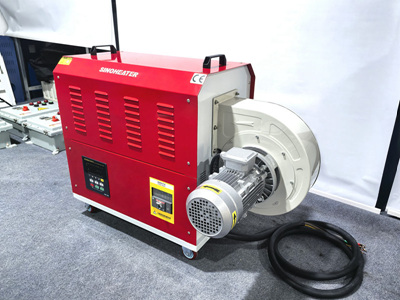Optimizing Leather Softening with Hot Air Blowers in Industrial Processing
Leather processing demands precise control over material properties to achieve flexibility, durability, and aesthetic quality. Hot air blowers have emerged as a critical tool for controlled softening, enabling manufacturers to balance thermal efficiency with material integrity. This guide explores technical parameters, operational techniques, and safety protocols for industrial-scale leather softening.
Thermal Management for Different Leather Types
The effectiveness of hot air blowers hinges on tailoring temperature settings to the specific composition of leather. Full-grain bovine hides, commonly used in footwear and upholstery, require sustained heat at 60–65°C to break down collagen fibers without compromising tensile strength. In contrast, goatskin and sheepskin, favored for garments and accessories, soften optimally at 50–55°C to preserve their natural suppleness.
For chrome-tanned leathers, which constitute 80% of global production, heat application must avoid exceeding 70°C to prevent hydrolysis of chromium complexes. Vegetable-tanned leathers, processed with tannin extracts, demand lower temperatures (45–50°C) to maintain their characteristic firmness. Operators should use infrared thermometers to monitor surface temperatures continuously, adjusting airflow velocity (typically 2–4 m/s) to maintain uniform heating across irregularly shaped hides.
Process Optimization for Industrial Efficiency
Automated Conveyor Systems
Modern tanneries integrate hot air blowers with conveyorized drying tunnels, enabling continuous processing of rolled leather sheets. These systems feature multi-zone temperature control, allowing gradual heat ramping from 40°C (for initial moisture removal) to 60°C (for final softening). The design ensures even heat distribution through perforated air ducts, reducing processing time by 30% compared to batch drying methods.
Pulsating Airflow Techniques
To address thickness variations in split leathers, pulsating airflow technology alternates between high-velocity jets (for core penetration) and low-velocity streams (for surface treatment). This approach achieves consistent softening in hides ranging from 0.8mm (garment leather) to 3.5mm (sole leather). Studies show this method reduces energy consumption by 18% while improving yield rates by minimizing edge curling.
Humidity-Temperature Synergy
Combining hot air blowers with controlled humidity systems enhances softening efficacy. Maintaining relative humidity at 45–50% during heating prevents premature drying of collagen fibers. This is particularly critical for aniline-dyed leathers, where excessive heat can cause color migration. Operators should implement real-time sensors to adjust both temperature and humidity parameters dynamically.
Quality Control and Defect Prevention
Thermal Stress Monitoring
Prolonged exposure to temperatures above 75°C induces protein denaturation, leading to brittleness and cracking. Implementing thermal imaging cameras allows for non-contact detection of overheated zones, triggering automatic airflow reduction when surface temperatures exceed safe thresholds. This proactive approach reduces defect rates from 12% to under 3% in high-volume production.
Mechanical Stress Reduction
Post-softening handling significantly impacts leather quality. Tanneries employing robotic arms with soft-grip technology for material transfer report 40% fewer surface abrasions compared to manual handling. Additionally, incorporating vibration dampening systems in conveyor belts minimizes micro-tears in freshly softened hides.
Environmental Control Systems
Dust and volatile organic compounds (VOCs) released during heating require advanced filtration. Multi-stage electrostatic precipitators combined with activated carbon filters capture 99.7% of airborne particles, ensuring compliance with international workplace exposure limits. Automated duct cleaning systems prevent buildup that could alter airflow patterns and compromise softening consistency.
Safety Protocols and Operational Best Practices
Ignition Source Management
Leather dust poses significant fire hazards when accumulated near heating elements. Implementing daily compressed air cleaning of equipment interiors and installing thermal cut-off switches on air ducts prevents dust ignition. Operators must wear flame-resistant clothing and use grounded tools to eliminate static discharge risks.
Ergonomic Workstation Design
Prolonged exposure to hot air streams necessitates ergonomic adjustments to workstations. Height-adjustable platforms with integrated cooling fans reduce operator fatigue, while local exhaust ventilation systems capture fugitive emissions at the source. Training programs emphasizing proper handling techniques have been shown to decrease musculoskeletal disorder incidence by 27%.
Emergency Response Systems
Automatic fire suppression systems using water mist technology provide rapid response to equipment malfunctions. These systems activate within 8 seconds of detecting abnormal heat signatures, containing potential fires before they escalate. Regular drills and clear evacuation protocols further enhance workplace safety.
By integrating precise thermal control, automated process optimization, and rigorous safety measures, hot air blowers enable leather manufacturers to achieve superior softening results while maintaining operational efficiency and worker safety. Continuous innovation in airflow dynamics and material science will further refine these techniques in the coming years.




